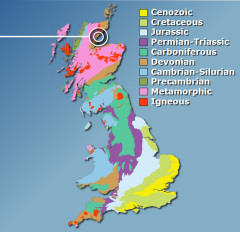
Established 2002
Lucinda Shepherd, friend Robert Randell and various experts for their support.
Dunrobin (Sutherland)

Click above to view page as a PDF.
Click here to download PDF software.
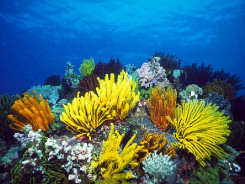
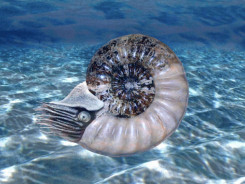
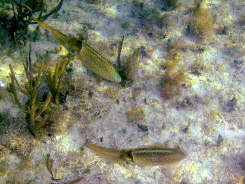

Introduction
Dunrobin is better known for its fairy-tail style castle Dunrobin Castle than its fossils, which in comparison are small in size and number; however experienced visitors should be able to locate a range of specimens from the Jurassic rocks accumulated at the base of the low-cliff. In comparison with other locations that yield Jurassic fossils, the find frequency at Dunrobin is very low and is therefore not recommended for collecting.


Left: Parking is
available in the main car park of Dunrobin Castle. Right:
Access to the beach is made via the southern side (right) of the
castle.
Parking is available in the castle car park throughout the year (above-left), from which a path descends to the foreshore via the south-side of the castle (above-right).
The geology of Dunrobin
The geology of the coast beneath Dunrobin Castle represents a transition during the Lower Jurassic (200 million years ago) from freshwater sediments, through estuarine deposits (with occasional marine influences) to fully marine. Evidence of this changing environment is clearly apparent from the change of fossils fauna within the foreshore exposures and the low-cliff.

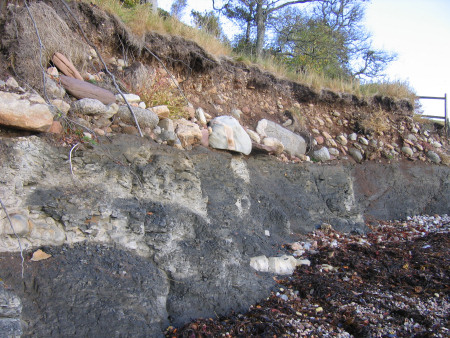
Left: Underlying marginal marine
sediments (White Sandstone Unit). Right: Marine sediments
(Lady's Walk Shale Member).
The following page is concerned with the exposures within the low-cliff (above-right), which specifically relates to a period of marine conditions during the early part of the Sinemurian stage (Lady's Walk Shale Member). The transition from the underlying White Sandstone Unit (semi-marine) can be clearly followed moving north-east.

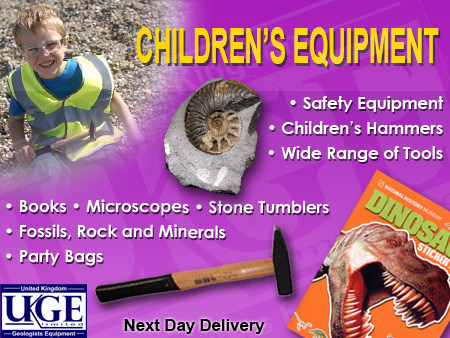
ADVERTISEMENT BY UKGE - OFFICIAL ADVERTISING PARTNER OF DISCOVERING FOSSILS
Where to look for fossils?
Fossils can found within intermittent exposures on the foreshore and within the eroded low-cliff (below-right); a low-tide is needed in order to observe foreshore exposures. During our recent visit the only exposures were at the top of the beach, within the low-cliff (Lady's Walk Shale Member), and it's here that the following page is based upon.


Left: View towards
Dunrobin Castle from the beach. Right: Sinemurian
marine sediments (Lady's Walk Shale Member) exposed by coastal
erosion.
Once on the beach, walk in north-east direction along the foreshore, passing in front of the magnificent castle (above-left), past the sea defenses (paved foreshore) and onwards towards the eroded shoreline (above-right).
For much of the year the high-tide doesn't reach the top of the pebbled beach and as such it's usually possible to find fossils. Please note that this stretch of coast has been assigned SSSI, which means extracting fossils directly from the exposures is not permitted; however collecting is allowed from the loose material accumulated at the base of the eroded shoreline.
As with all coastal locations, a fossil hunting trip is best timed to coincide with a falling or low-tide. For a relatively low one-off cost we recommend the use of Neptune Tides software, which provides future tidal information around the UK. To download a free trial click here. Alternatively a free short range forecast covering the next 7 days is available on the BBC website click here.
What fossils might you find?
It takes quite some time to gather enough specimens to begin to build a picture of what life was like in this region 200 million years ago; with patience bivalves, brachiopods, belemnites and ammonites (reported but not observed during our recent visit) can be found. The following specimens were collected from the Lady's Walk Shale Member (see notes above).
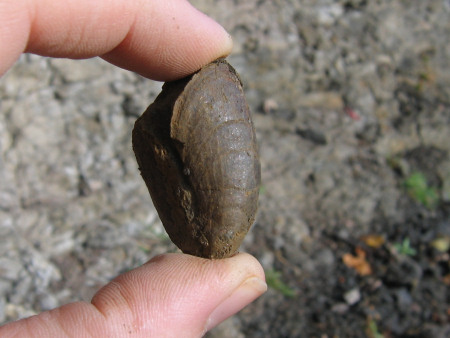
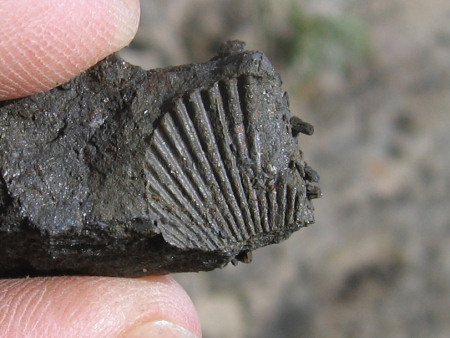
Left: A small
bivalve. Right: The inner surface of a small brachiopod shell.
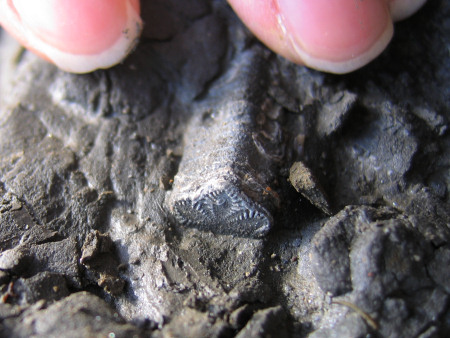
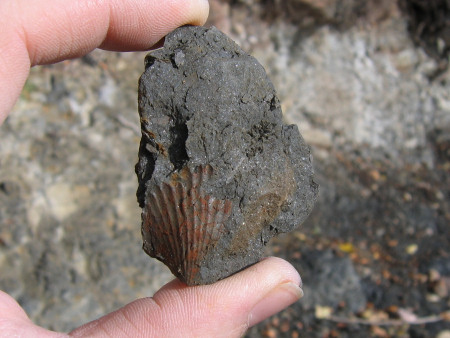
Left: A fragment of
crinoid stem (Balanocrinus). Right:
The inner cast of a small brachiopod shell.
The crinoid fragment (above-left) has been identified by the Hunterian Museum as a significant find for Dunrobin, and a paper to describe it has been produced click here.
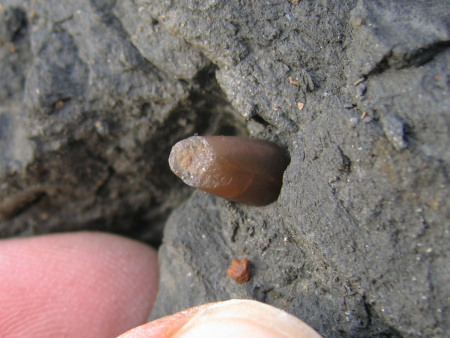
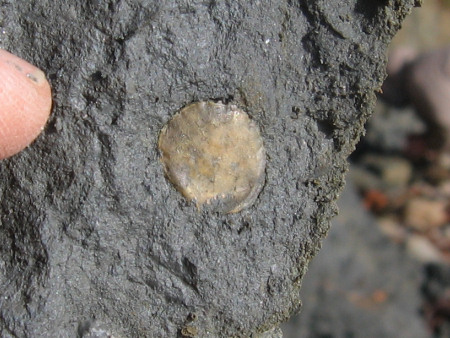
Left: The broken
tip of a small belemnite guard protruding from the eroded coastline.
Right: A small bivalve.
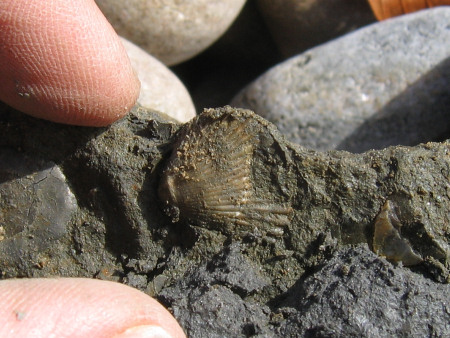

Left: A partly squashed
brachiopod.
Right: A small brachiopod from the White Sandstone Unit.
The final photo (above-right) is included to represent the underlying White Sandstone Unit; the sandy sediment represents a marine-marginal facies.
Tools & equipment
It's a good idea to spend some time considering the tools and equipment you're likely to require while fossil hunting at Dunrobin. Preparation in advance will help ensure your visit is productive and safe. Below are some of the items you should consider carrying with you. You can purchase a selection of geological tools and equipment online from UKGE.
Steel point: In some instances it's not necessary to use a hammer and chisel to remove the matrix surrounding the fossil. Sometimes all that's required is some careful precision work using a steel point. This is particularly relevant with crumbly matrix, where chiselling may otherwise shatter a fragile fossil.
Hand lens: A hand lens enables the fossil hunter to enjoy the finer details of the specimens they find. It's often remarkable how well preserved some of the most intricate structures can be. We recommend a lens with x10 magnification that folds away into a metal casing to protect it from damage.
Strong bag: When considering the type of bag to use it's worth setting aside one that will only be used for fossil hunting, rocks are usually dusty or muddy and will make a mess of anything they come in contact with. The bag will also need to carry a range of accessories which need to be easily accessible. Among the features recommended include: brightly coloured, a strong holder construction, back support, strong straps, plenty of easily accessible pockets and a rain cover.
Walking boots: A good pair of walking boots will protect you from ankle sprains, provide more grip on slippery surfaces and keep you dry in wet conditions. During your fossil hunt you're likely to encounter a variety of terrains so footwear needs to be designed for a range of conditions.
For more information and examples of tools and equipment recommended for fossil hunting click here or shop online at UKGE.


ADVERTISEMENT BY UKGE - OFFICIAL ADVERTISING PARTNER OF DISCOVERING
FOSSILS
Protecting your finds
It's important to spend some time considering the best way to protect your finds onsite, in transit, on display and in storage. Prior to your visit, consider the equipment and accessories you're likely to need, as these will differ depending on the type of rock, terrain and prevailing weather conditions.


Left: Fossil
wrapped in foam, ready for transport. Right:
A small compartment box containing cotton wool is ideal for
separating delicate specimens.
When you discover a fossil, examine the surrounding matrix (rock) and consider how best to remove the specimen without breaking it; patience and consideration are key. The aim of extraction is to remove the specimen with some of the matrix attached, as this will provide added protection during transit and future handling; sometimes breaks are unavoidable, but with care you should be able to extract most specimens intact. In the event of breakage, carefully gather all the pieces together, as in most cases repairs can be made at a later time.
For more information about collecting fossils please refer to the following online guides: Fossil Hunting and Conserving Prehistoric Evidence.
Join us on a fossil hunt
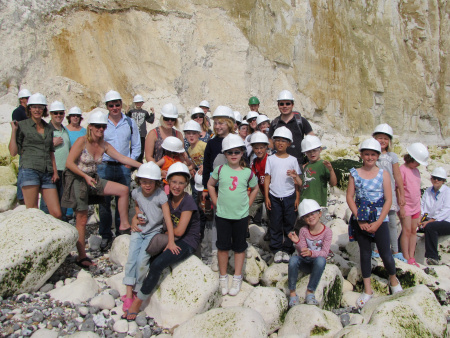

Left: A birthday party with
a twist - fossil hunting at
Peacehaven.
Right: A family hold their prized ammonite at Beachy Head.
Discovering Fossils guided fossil hunts reveal evidence of life that existed millions of years ago. Whether it's your first time fossil hunting or you're looking to expand your subject knowledge, our fossil hunts provide an enjoyable and educational experience for all. To find out more CLICK HERE

